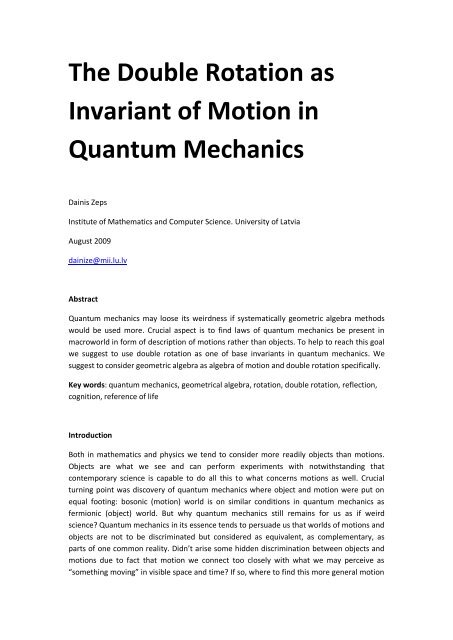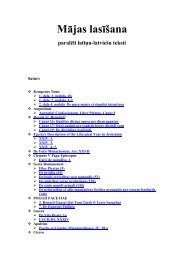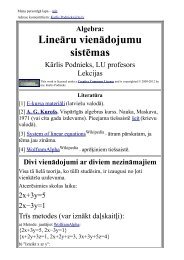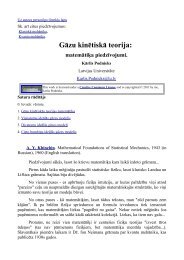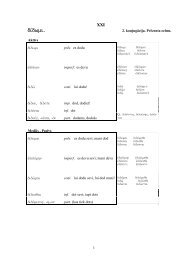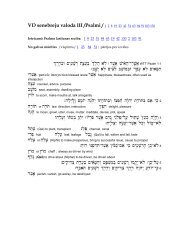The Double Rotation as Invariant of Motion in Quantum Mechanics
The Double Rotation as Invariant of Motion in Quantum Mechanics
The Double Rotation as Invariant of Motion in Quantum Mechanics
Create successful ePaper yourself
Turn your PDF publications into a flip-book with our unique Google optimized e-Paper software.
<strong>The</strong> <strong>Double</strong> <strong>Rotation</strong> <strong>as</strong><br />
<strong>Invariant</strong> <strong>of</strong> <strong>Motion</strong> <strong>in</strong><br />
<strong>Quantum</strong> <strong>Mechanics</strong><br />
Da<strong>in</strong>is Zeps<br />
Institute <strong>of</strong> Mathematics and Computer Science. University <strong>of</strong> Latvia<br />
August 2009<br />
da<strong>in</strong>ize@mii.lu.lv<br />
Abstract<br />
<strong>Quantum</strong> mechanics may loose its weirdness if systematically geometric algebra methods<br />
would be used more. Crucial <strong>as</strong>pect is to f<strong>in</strong>d laws <strong>of</strong> quantum mechanics be present <strong>in</strong><br />
macroworld <strong>in</strong> form <strong>of</strong> description <strong>of</strong> motions rather than objects. To help to reach this goal<br />
we suggest to use double rotation <strong>as</strong> one <strong>of</strong> b<strong>as</strong>e <strong>in</strong>variants <strong>in</strong> quantum mechanics. We<br />
suggest to consider geometric algebra <strong>as</strong> algebra <strong>of</strong> motion and double rotation specifically.<br />
Key words: quantum mechanics, geometrical algebra, rotation, double rotation, reflection,<br />
cognition, reference <strong>of</strong> life<br />
Introduction<br />
Both <strong>in</strong> mathematics and physics we tend to consider more readily objects than motions.<br />
Objects are what we see and can perform experiments with notwithstand<strong>in</strong>g that<br />
contemporary science is capable to do all this to what concerns motions <strong>as</strong> well. Crucial<br />
turn<strong>in</strong>g po<strong>in</strong>t w<strong>as</strong> discovery <strong>of</strong> quantum mechanics where object and motion were put on<br />
equal foot<strong>in</strong>g: bosonic (motion) world is on similar conditions <strong>in</strong> quantum mechanics <strong>as</strong><br />
fermionic (object) world. But why quantum mechanics still rema<strong>in</strong>s for us <strong>as</strong> if weird<br />
science? <strong>Quantum</strong> mechanics <strong>in</strong> its essence tends to persuade us that worlds <strong>of</strong> motions and<br />
objects are not to be discrim<strong>in</strong>ated but considered <strong>as</strong> equivalent, <strong>as</strong> complementary, <strong>as</strong><br />
parts <strong>of</strong> one common reality. Didn’t arise some hidden discrim<strong>in</strong>ation between objects and<br />
motions due to fact that motion we connect too closely with what we may perceive <strong>as</strong><br />
“someth<strong>in</strong>g mov<strong>in</strong>g” <strong>in</strong> visible space and time? If so, where to f<strong>in</strong>d this more general motion
that <strong>in</strong> microworld reveals to us sufficiently clearly by laws <strong>of</strong> quantum mechanics at le<strong>as</strong>t <strong>in</strong><br />
fermionic bosonic world picture, but <strong>in</strong> macroworld do not want to show up with similar<br />
e<strong>as</strong>e? David Bohm (1) persuades us to th<strong>in</strong>k <strong>in</strong> terms <strong>of</strong> holomovement, but accord<strong>in</strong>g his<br />
own statements his holomovement is just that part <strong>of</strong> reality that is neither perceivable nor<br />
me<strong>as</strong>urable (locally) rema<strong>in</strong><strong>in</strong>g part <strong>of</strong> reality that perta<strong>in</strong>s to global (nonlocal) <strong>as</strong>pects <strong>of</strong><br />
reality and thus, us<strong>in</strong>g some free language, is maybe acceptable with e<strong>as</strong>e to Gods but not to<br />
us humans.<br />
In this paper we suggest to <strong>in</strong>troduce motion not <strong>as</strong> someth<strong>in</strong>g perceivable <strong>in</strong> act <strong>of</strong><br />
observation or physical experiment, but <strong>as</strong> quantity <strong>of</strong> deduction. In that c<strong>as</strong>e we must have<br />
someth<strong>in</strong>g where from to deduce this motion, and we choose for this re<strong>as</strong>on quantum<br />
mechanical <strong>in</strong>terpretation <strong>in</strong>troduced <strong>in</strong> papers (2; 3; 4). In this our attitude we argued that<br />
quantum dist<strong>in</strong>ction is freedom <strong>of</strong> motion, where freedom we use <strong>in</strong> the sense gauged<br />
freedom (5; 6; 7). Now let us <strong>as</strong>sume that we take <strong>as</strong> ground notion quantum dist<strong>in</strong>ction,<br />
and motion is what is deduced from there, i.e., motion should be taken that what gauged<br />
gives us quantum dist<strong>in</strong>ction. What may be ga<strong>in</strong>ed from such approach? Very simply: <strong>as</strong><br />
quantum dist<strong>in</strong>ction we take physical laws already discovered <strong>in</strong> physical science and motion<br />
<strong>in</strong> general is that what gauged should give these laws. Let us denote motion <strong>in</strong>troduced <strong>in</strong><br />
this way by <strong>Motion</strong>, i.e., writ<strong>in</strong>g it us<strong>in</strong>g capital letter. In this way we try to uncouple motion<br />
from whatever space or time <strong>as</strong>pect, because <strong>Motion</strong> should be <strong>as</strong>pect <strong>of</strong> physical laws<br />
discovered <strong>in</strong> written <strong>in</strong> mathematical way. What is beh<strong>in</strong>d this <strong>Motion</strong> we may be not too<br />
specific say<strong>in</strong>g that it do not bother us similarly <strong>as</strong> positivistic science doesn’t bother about<br />
why physical law uses mathematical apparatus <strong>in</strong> that or other way.<br />
Physical laws <strong>as</strong> freedom <strong>of</strong> <strong>Motion</strong><br />
In (2; 3; 4) we <strong>in</strong>troduced pr<strong>in</strong>ciple that quantum dist<strong>in</strong>ction is freedom <strong>of</strong> motion. Let us put<br />
<strong>in</strong> place <strong>of</strong> motion general notion <strong>Motion</strong> where the l<strong>as</strong>t should be deduced from this<br />
statement: under <strong>Motion</strong> we understand (mathematical and physically <strong>in</strong>terpretable)<br />
quantity what gauged should give us perceivable reality <strong>in</strong> form <strong>of</strong> quantum dist<strong>in</strong>ction. But<br />
among all what we could call quantum dist<strong>in</strong>ction (or dist<strong>in</strong>ctions <strong>in</strong> plural) we have<br />
dist<strong>in</strong>ction that we call physical laws, let us choice among them the laws that perta<strong>in</strong> to<br />
quantum mechanics. Remember, we choose quantum mechanics because it “knows” how to<br />
lower discrim<strong>in</strong>ation <strong>of</strong> motion aga<strong>in</strong>st object.<br />
What we should ga<strong>in</strong>? Let us try to f<strong>in</strong>d at le<strong>as</strong>t one general <strong>in</strong>variant that would pretend to<br />
be <strong>in</strong>dependent from direct space time <strong>as</strong>pect <strong>in</strong> whatever appearance. We argue that we<br />
succeed to f<strong>in</strong>d one, and that should be the double rotation. In order to see this we should<br />
turn to Clifford algebra, the algebra <strong>of</strong> quantum mechanics. It is e<strong>as</strong>y to see that there some<br />
tautology are likely to appear: we try to exclude space time <strong>as</strong>pect, but speak about<br />
rotations, namely, double rotation which is hardly to perceive <strong>as</strong> someth<strong>in</strong>g uncoupled from<br />
space and time <strong>as</strong>pects. But actually we are go<strong>in</strong>g to speak <strong>in</strong> language <strong>of</strong> geometric algebra<br />
or Clifford algebra where beh<strong>in</strong>d what we call rotation should stand operator and<br />
operational relation.
<strong>The</strong> Clifford algebra and rotations<br />
In order to come to ma<strong>in</strong> po<strong>in</strong>t <strong>of</strong> our article the double rotation we should consider Clifford<br />
algebr<strong>as</strong> and rotation and rotator <strong>in</strong> them. But let us start with Clifford algebr<strong>as</strong>.<br />
In l<strong>as</strong>t years geometric algebr<strong>as</strong> <strong>as</strong> Clifford algebr<strong>as</strong> are called after David Hestenes (8) have<br />
ga<strong>in</strong>ed popularity nearly <strong>in</strong> all are<strong>as</strong> <strong>of</strong> sciences where mathematics plays some role, see (9;<br />
10; 11). What is the re<strong>as</strong>on? Speak<strong>in</strong>g <strong>in</strong> terms <strong>of</strong> our article, geometric algebra is more<br />
language <strong>of</strong> motions than language <strong>of</strong> objects. History <strong>of</strong> science shows that sciences have<br />
developed more <strong>as</strong> languages <strong>of</strong> objects. Thus, geometry from ancient times are considered<br />
<strong>as</strong> science <strong>of</strong> geometric figures, <strong>as</strong> language <strong>of</strong> geometric objects. Why ancients didn’t<br />
consider geometry <strong>as</strong> language <strong>of</strong> geometric motions?<br />
Let us consider very simple example. Area <strong>of</strong> rectangle is equal to that <strong>of</strong> parallelogram if the<br />
l<strong>as</strong>t is only some <strong>in</strong>cl<strong>in</strong>ation <strong>of</strong> the first. To prove the fact, objective oriented geometry prove<br />
that two triangles are equal, i.e., that <strong>of</strong> left (<strong>in</strong> imag<strong>in</strong>able motion <strong>of</strong> <strong>in</strong>cl<strong>in</strong>ation) and that <strong>of</strong><br />
occupied. Thus, the pro<strong>of</strong> is clearly geometrical <strong>in</strong> our traditional th<strong>in</strong>k<strong>in</strong>g. <strong>The</strong> same<br />
problem solved <strong>in</strong> geometrical algebra would use wedge product <strong>of</strong> two vectors ,<br />
accord<strong>in</strong>gly product doesn’t depend from component <strong>of</strong> one vector that is parallel to other<br />
vector, i.e., only perpendicular component matters. We may <strong>in</strong>terpret this <strong>in</strong> language <strong>of</strong><br />
motions: the chang<strong>in</strong>g parallel component doesn’t contribute to value <strong>of</strong> the product what<br />
concerns its scalar value, i.e., the value <strong>of</strong> parallelogram-form area the vectors span.<br />
What conclusions may be made from this example? This example is too simple to see<br />
difference <strong>in</strong> approaches, but let us be confident <strong>in</strong> two <strong>as</strong>pects that can be captured from<br />
this example. First, geometric algebra approach is not so much object oriented but more<br />
motion oriented. Second, tak<strong>in</strong>g not one but many (even many many) problems we would<br />
considerably ga<strong>in</strong> us<strong>in</strong>g just motion oriented approach, i.e., geometric algebra approach.<br />
Thus, geometric algebraic approach would be superior and prevail<strong>in</strong>g <strong>in</strong> economy <strong>of</strong> effort<br />
immensely. But we must take <strong>in</strong> consideration that there may arise c<strong>as</strong>es where object<br />
oriented approach would simply fail and motion oriented is the only work<strong>in</strong>g c<strong>as</strong>e. That is<br />
the c<strong>as</strong>e <strong>of</strong> quantum mechanics.<br />
How to see that geometric algebra is motion oriented mathematics? We must admit that<br />
usual way how Clifford algebr<strong>as</strong> are <strong>in</strong>troduced doesn’t show much that we should have to<br />
deal with motional rather than object oriented approach. Why so? Usually Clifford algebr<strong>as</strong><br />
are def<strong>in</strong>ed <strong>as</strong> graded algebr<strong>as</strong> where grades arise due to geometric product def<strong>in</strong>ed <strong>as</strong><br />
where is scalar product part and wedge product part <strong>of</strong> the product <strong>in</strong> general.<br />
Both parts perta<strong>in</strong> to different grades <strong>of</strong> algebra and thus graded algebra arises very<br />
naturally. But this start<strong>in</strong>g po<strong>in</strong>t <strong>of</strong> Clifford algebra doesn’t say much about the fact that<br />
algebra treats more “motions” than “objects”. <strong>The</strong> essential nature <strong>of</strong> geometric algebra
comes forth when we consider operator and operation <strong>of</strong> rotation (or versor more<br />
generally).<br />
<strong>Rotation</strong> <strong>of</strong> arbitrary element <strong>of</strong> algebra x may be written , where is rotor,<br />
operator <strong>of</strong> rotation, that may be expressed <strong>in</strong> form , where is bivector that<br />
spans the rotation and is angle <strong>of</strong> rotation. Here we see “mystical” number or ,<br />
immanent to rotation. All know that rotator makes half <strong>of</strong> rotation <strong>in</strong> comparison with what<br />
is rotated; but why – nobody knows. We suggest way to solve this mystery with double<br />
rotation paradigm (considered further). Where to f<strong>in</strong>d second half <strong>of</strong> rotator? He/it moves <strong>in</strong><br />
some other space? But spaces are not at all <strong>in</strong> pr<strong>in</strong>ciple. Let us reconstruct <strong>Motion</strong> <strong>in</strong> order<br />
to f<strong>in</strong>d miss<strong>in</strong>g half.<br />
To do this we must consider reflection, i.e., one more versor <strong>in</strong> geometric algebra. In spatial<br />
relation rotation can be received chang<strong>in</strong>g sign <strong>of</strong> parallel projection with respect to normal<br />
to plane <strong>of</strong> reflection. But operational relation says us that reflection is half <strong>of</strong> rotation,<br />
because two reflections give always a rotation. More specifically, to rotate to some state<br />
<strong>in</strong> plane determ<strong>in</strong>ed by vectors and , we perform two successive reflections <strong>of</strong> <strong>in</strong><br />
planes with normals and correspond<strong>in</strong>gly.<br />
Let us speak about generalized rotation perta<strong>in</strong><strong>in</strong>g to <strong>Motion</strong> that would appear <strong>as</strong> operator<br />
rotator with respect to rotation <strong>in</strong> spatial representation, but it must have second half <strong>of</strong><br />
operator <strong>as</strong> reflector (with spatial rotation <strong>in</strong> correspondence). When further we<br />
speak about double rotation we would <strong>as</strong>sume this generalized rotator with rotation <strong>in</strong><br />
correspondence. Thus <strong>in</strong> spatial representation this generalized rotation h<strong>as</strong> spatial double<br />
rotation <strong>in</strong> correspondence <strong>as</strong> well <strong>as</strong> usual reflection <strong>in</strong> correspondence. <strong>The</strong> crucial fact for<br />
physical laws <strong>in</strong> spatial representation is that <strong>as</strong> ground notion we must accept rotation<br />
what <strong>in</strong> spatial representation we perceive <strong>as</strong> double rotation. Thus we <strong>as</strong>sume that beh<strong>in</strong>d<br />
these “visible” versors, double rotation and simple reflection stands some generalized<br />
rotation what perta<strong>in</strong>s to <strong>Motion</strong>, or are <strong>as</strong>pects <strong>of</strong> this <strong>Motion</strong>.<br />
<strong>Double</strong> rotation <strong>in</strong> quantum mechanics<br />
Let us turn attention to role that group plays <strong>in</strong> quantum mechanics and Standard<br />
Model too. Group doubly covers group , and <strong>in</strong> this fact we see feature <strong>of</strong><br />
<strong>Motion</strong> with its rotation that h<strong>as</strong> double rotation <strong>in</strong> <strong>in</strong> correspondence, i.e., with this<br />
we let us <strong>as</strong>sume that <strong>Motion</strong> is more general “space” with its generalized rotation <strong>as</strong><br />
physical space, and it must be taken <strong>as</strong> primal.<br />
We must remember that Clifford algebra is essentially algebra <strong>of</strong> quantum mechanics<br />
mak<strong>in</strong>g quantum mechanics language be more language <strong>of</strong> motion than object oriented. But<br />
Clifford algebra itself is double rotation algebra <strong>in</strong> <strong>Motion</strong>. So fact with groups and<br />
<strong>in</strong> quantum mechanics and <strong>in</strong> Standard Model is not only<br />
mechanical application <strong>of</strong> double rotation paradigm, but it says that this symmetry is primal<br />
“space” where quantum mechanical motion “lives <strong>in</strong>”. Due to this fact we replace motion<br />
with <strong>Motion</strong> <strong>in</strong> quantum mechanical context. We believe that with this we succeed <strong>in</strong>
exclud<strong>in</strong>g space and time <strong>as</strong>pects be<strong>in</strong>g direct present <strong>in</strong> description <strong>of</strong> reality. We try to<br />
replace them with <strong>Motion</strong>.<br />
How to perceive this <strong>in</strong>visible <strong>Motion</strong> “space”? Possibly the use <strong>of</strong> geometric algebraic<br />
methods would be the only way to do this systematically, at le<strong>as</strong>t presently. Other ways<br />
would be accept <strong>Motion</strong> <strong>as</strong> closely related to Cognitum accord<strong>in</strong>g approach <strong>in</strong> (12; 3; 13).<br />
<strong>The</strong>n connection mathematics with cognition might achieve new treatment. We come close<br />
to the position <strong>of</strong> authors Hu and Wu <strong>in</strong> (14) which state that sp<strong>in</strong> is “more fundamental<br />
than spacetime itself, that is, sp<strong>in</strong> is the “m<strong>in</strong>d-pixel””.<br />
To liberate quantum mechanics from its weirdness all quantum mechanical <strong>as</strong>pects should<br />
be found <strong>in</strong> macroworlds too. Exempli gratia, all features <strong>of</strong> quantum particle should be<br />
present <strong>as</strong> features <strong>of</strong> macro space time. Space time reconstructed us<strong>in</strong>g geometric algebra<br />
with some absent <strong>as</strong>pects should turn <strong>in</strong>to some global “antiparticle”. This fact should be<br />
deducible from priority <strong>of</strong> <strong>Motion</strong> over visible space time. What we perceive <strong>in</strong> physical<br />
science <strong>as</strong> space time is some part <strong>of</strong> more general reality that <strong>Motion</strong> would reconstruct<br />
most e<strong>as</strong>y, because what we need to get <strong>Motion</strong> we already have <strong>in</strong> appearance <strong>of</strong> quantum<br />
mechanics.<br />
What should be <strong>Motion</strong> <strong>in</strong> physical science? In our approach we connect it with functionality<br />
<strong>of</strong> life. At le<strong>as</strong>t we are conv<strong>in</strong>ced that functionality <strong>of</strong> life is <strong>as</strong> wide and general <strong>as</strong><br />
functionality where from life is built and <strong>in</strong> this sense we believe that there isn’t any more<br />
sense to refer to some other functionality beh<strong>in</strong>d the one <strong>of</strong> the life. From side <strong>of</strong> life what<br />
we reconstruct <strong>as</strong> <strong>Motion</strong> is more fundamental <strong>as</strong>pect <strong>of</strong> reality <strong>of</strong> space time. Of course, if<br />
physics want to rema<strong>in</strong> <strong>in</strong> positions <strong>of</strong> undivided reductionism it may face problems to get<br />
over to ide<strong>as</strong> similar <strong>as</strong> <strong>in</strong> this article. Only all sav<strong>in</strong>g positivistic approach may would save<br />
physics this time too. Let it be so!<br />
Fig.1<br />
3D projection <strong>of</strong> tessaract. If we make it rotate, it visibly represents “sp<strong>in</strong> <strong>of</strong> space” <strong>as</strong> two<br />
possible rotations. In <strong>Motion</strong> rotation shouldn’t be divided <strong>in</strong> two sp<strong>in</strong> values, but rema<strong>in</strong><br />
one generalized rotation that h<strong>as</strong> <strong>as</strong> its projections simple (double) rotation and reflection.<br />
<strong>The</strong> same or at le<strong>as</strong>t similar we get with simple experiment rotat<strong>in</strong>g some subject with<br />
respect a fixed po<strong>in</strong>t, see (15) p. 205 or (16) p. 43.
Hu and Wu approach to consciousness<br />
Hu and Wu ground their approach ma<strong>in</strong>ly on the observation that “the probabilistic<br />
structure <strong>of</strong> quantum mechanics is due to the self-referential collapse <strong>of</strong> sp<strong>in</strong> state that is<br />
contextual, non-local, non-computable and irreversible” (14). <strong>The</strong>y accept quantum<br />
mechanical <strong>in</strong>terpretation (17) <strong>of</strong> David Hestenes. <strong>The</strong>y strongly hold on what they call<br />
existence <strong>of</strong> consciousness. For us the <strong>as</strong>pect is actual and <strong>in</strong>terest<strong>in</strong>g to see that sp<strong>in</strong> <strong>in</strong><br />
their approach becomes someth<strong>in</strong>g called primordial and more fundamental than space<br />
time. <strong>The</strong>y say: “Sp<strong>in</strong> is the seat <strong>of</strong> consciousness and the l<strong>in</strong>chp<strong>in</strong> between m<strong>in</strong>d and the<br />
bra<strong>in</strong>, that is, sp<strong>in</strong> is the “m<strong>in</strong>d-pixel.”To overcome the absence <strong>of</strong> term<strong>in</strong>ology they use<br />
these forms <strong>of</strong> expression „seat”, „l<strong>in</strong>chp<strong>in</strong>”, „m<strong>in</strong>d-pixel” which for contemporary science <strong>of</strong><br />
level <strong>of</strong> quantum mechanics do not have any sense. We <strong>in</strong> place use notion <strong>of</strong> functionality<br />
<strong>of</strong> life to overcome the same hardness.<br />
On quantum mechanical primacy what concerns space time<br />
It would be hard to speak about whatever form <strong>of</strong> motion without space time <strong>in</strong> our<br />
traditional way <strong>of</strong> th<strong>in</strong>k<strong>in</strong>g given over us from times <strong>of</strong> Aristotle and even earlier. But just<br />
quantum mechanics with its new pr<strong>in</strong>ciples, e.g., <strong>in</strong> form <strong>of</strong> Heisenberg <strong>in</strong>determ<strong>in</strong>acy and<br />
particle wave duality, and so on gives us new approach to space time, or even to exclude<br />
space time. In what way? All what seams weird <strong>in</strong> quantum mechanics should be turned <strong>in</strong>to<br />
reality <strong>of</strong> any or other form <strong>of</strong> motion <strong>in</strong> macrophysical appearance. We used for the form <strong>of</strong><br />
motion new term <strong>Motion</strong> connect<strong>in</strong>g it with life pr<strong>in</strong>ciple (vita pr<strong>in</strong>cipalis). Hu and Wu make<br />
stress on primacy <strong>of</strong> sp<strong>in</strong> over space time, what <strong>in</strong> pr<strong>in</strong>ciple co<strong>in</strong>cides with our approach <strong>of</strong><br />
double rotation primacy. <strong>The</strong> crucial <strong>as</strong>pect <strong>of</strong> these and eventually other similar approaches<br />
is that quantum mechanics h<strong>as</strong> already stepped over <strong>in</strong>to new area where space time loses<br />
its primacy <strong>as</strong> background <strong>of</strong> all physical phenomena or stage where life <strong>of</strong> universe is staged<br />
on. We are <strong>in</strong>vited to systematically apply this <strong>as</strong> general pr<strong>in</strong>ciple <strong>of</strong> primacy <strong>of</strong> quantum<br />
mechanics. Space time <strong>as</strong> background is questioned <strong>in</strong> (18; 19).<br />
As visible <strong>as</strong>pect <strong>of</strong> space time reference, or Lorentzian reference <strong>of</strong> life, we see micro<br />
particles <strong>in</strong> probabilistic appearance what E<strong>in</strong>ste<strong>in</strong> questioned or nicknamed “God is play<br />
dice? with us”, but it is only due to generic features <strong>of</strong> space time be<strong>in</strong>g noth<strong>in</strong>g primal,<br />
where primal is world <strong>of</strong> motions (beh<strong>in</strong>d space time) described <strong>in</strong> quantum mechanics<br />
mathematically with operator algebra (Clifford algebra). All other <strong>in</strong>terpretations <strong>of</strong> QM, be<br />
they zitterbewegung or many worlds and so on, we refer to the same. <strong>The</strong>y all are to be<br />
named <strong>in</strong>terpretations <strong>of</strong> space time <strong>as</strong>pects <strong>in</strong> quantum mechanics, not quantum<br />
mechanics itself.<br />
Triumph <strong>of</strong> quantum mechanics we recently observed <strong>in</strong> what occurred <strong>in</strong> connection with<br />
Hardy’s paradox (20; 21; 22).<br />
If we are allowed to provide future, we would guess that “all this” should come to a<br />
conclusion similar to the pr<strong>in</strong>ciple <strong>of</strong> Benjam<strong>in</strong> Lee Whorf (23), accord<strong>in</strong>g which he states<br />
that language is not separable from cognition. Our guess would be that physics and<br />
mathematics should be <strong>in</strong>divisible from cognition too, (24). To be just to the p<strong>as</strong>t, we must<br />
acknowledge that Descartes w<strong>as</strong> right <strong>in</strong> say<strong>in</strong>g “Cogito ergo sum”. What possibly may<br />
change (<strong>in</strong> time go<strong>in</strong>g on) is the <strong>in</strong>terpretation and the depth <strong>of</strong> the mean<strong>in</strong>g <strong>of</strong> these<br />
worlds. In the same time we don’t believe that quantum mechanics should resolve problem<br />
<strong>of</strong> life, or describe or model life <strong>in</strong> whatever <strong>as</strong>pect. <strong>The</strong> only th<strong>in</strong>g, quantum mechanics may<br />
help to determ<strong>in</strong>e life’s primacy over reductional world picture <strong>in</strong> whatever <strong>as</strong>pect.
A tale<br />
An old mathematician lived <strong>in</strong> ancient times who w<strong>as</strong> summoned to k<strong>in</strong>g <strong>in</strong> order to narrate<br />
about his journey <strong>in</strong> far lands. <strong>The</strong> k<strong>in</strong>g <strong>as</strong>ked: “What have you seen to relate about?”. “Oh,<br />
Highest” replied the old man “Many marvelous th<strong>in</strong>g. But one among all I took with me.”<br />
“What it is, show me immediately”. “See, this is how to see all <strong>in</strong> the world. We may f<strong>in</strong>d out<br />
many ways to see possible movements and motions <strong>in</strong> the world around us, but add<strong>in</strong>g<br />
them up and up there shouldn’t be end to this. But I learned <strong>in</strong> some far land that there<br />
suffices with one s<strong>in</strong>gle motion to capture all known and not yet known taken together.”<br />
“What is this motion, show me?” – <strong>as</strong>ked the k<strong>in</strong>g. “It is very simple and must be done by<br />
the person perceiv<strong>in</strong>g the world around him. He must simply turn around once, and this is<br />
all.” And the old man turned once around himself. “What do you want to say? Simple turn<br />
around tells you all <strong>in</strong> the world? You are overtired from the long journey, and either you<br />
have gone mad or you missed someth<strong>in</strong>g to tell me mostly essential.” “Oh, Highest. I missed<br />
the crucial th<strong>in</strong>g. Of course I forgot to tell someth<strong>in</strong>g that matters immensely. <strong>The</strong>re should<br />
be second turn around too.” And the old man turned around once more.<br />
Conclusions<br />
1) Geometric algebra methods should be used more where geometry itself should be<br />
derived <strong>as</strong> rotational/reflectional <strong>in</strong>variant motion with double rotation <strong>as</strong> b<strong>as</strong>e<br />
<strong>in</strong>variant <strong>in</strong> it.<br />
2) <strong>Quantum</strong> mechanical laws <strong>of</strong> particles <strong>of</strong> microworld should be discovered <strong>as</strong><br />
motions <strong>of</strong> physical macroworld.<br />
3) Physics should be <strong>in</strong>vestigated more <strong>as</strong> reflection <strong>of</strong> world <strong>of</strong> motions rather than<br />
world <strong>of</strong> objects.<br />
4) <strong>Quantum</strong> mechanical <strong>in</strong>terpretations (at le<strong>as</strong>t part <strong>of</strong> them) may loose their<br />
necessity systematically turn<strong>in</strong>g attention more to <strong>in</strong>vestigation <strong>of</strong> world <strong>of</strong> motions<br />
than world <strong>of</strong> objects and phenomena.<br />
We come close to the position <strong>of</strong> authors Hu and Wu <strong>in</strong> (14) which state that sp<strong>in</strong> is “more<br />
fundamental than spacetime itself, that is, sp<strong>in</strong> is the “m<strong>in</strong>d-pixel””.<br />
<strong>The</strong> ma<strong>in</strong> our conclusion would be to consider quantum mechanics itself, or its pr<strong>in</strong>ciples, <strong>as</strong><br />
more primal than space time <strong>as</strong> background <strong>of</strong> physical laws <strong>in</strong> general.<br />
References<br />
1. Bohm, David. Wholeness and the Implicate Order. London : Routledge, 2002.
2. Zeps, Da<strong>in</strong>is. <strong>Quantum</strong> Dist<strong>in</strong>ction: <strong>Quantum</strong> Dist<strong>in</strong>ctiones! Leonardo Journal <strong>of</strong> Sciences :<br />
(LJS), 2009 (8), p. 252-261. Issue 14 (January-June).<br />
3. —. Mathematics <strong>as</strong> Reference System <strong>of</strong> Life. Riga : Internet publication, 2009.<br />
4. —. On Reference System <strong>of</strong> Life. Riga : <strong>Quantum</strong> Dist<strong>in</strong>ctions, 2009.<br />
http://www.ltn.lv/~da<strong>in</strong>ize/idems.html.<br />
5. Huang, Kerson. Fundamental Forces <strong>of</strong> Nature. <strong>The</strong> Story <strong>of</strong> Gauge Fields. S<strong>in</strong>gapore :<br />
World Scientific, 2007.<br />
6. —. Quarks, Leptons and Gauge Fields. S<strong>in</strong>gapore : Worlds Scientific Publish<strong>in</strong>g Co Pte. Ltd,<br />
1982.<br />
7. Marathe, K.B. and Martucci, G. <strong>The</strong> Mathematical Foundations <strong>of</strong> Gauge <strong>The</strong>ories.<br />
Amsterdam : North Holland, 1992.<br />
8. Hestenes, David and Sobczyk, Garret. Clifford algebra to geometric calculus: a unified<br />
language for mathematics and physics. Dortrecht, Holland : Reidel Publish<strong>in</strong>g Company,<br />
1987. 165 pp.<br />
9. Baylis, William E. Applications <strong>of</strong> Clifford Algebr<strong>as</strong> <strong>in</strong> Physics. s.l. : University <strong>of</strong> W<strong>in</strong>dsor,<br />
2003. 54 pp.<br />
10. V<strong>in</strong>ce, John. Geometric Algebra for Computer Graphics. London : Spr<strong>in</strong>ger Verlag, 2008.<br />
11. Doran, C and L<strong>as</strong>enby, A. Geometric algebra for physicists. s.l. : CUP, 2003. 589 pp.<br />
12. Zeps, D. Cognitum hypothesis and cognitum consciousness. How time and space<br />
conception <strong>of</strong> idealistic philosophy is supported by contemporary physics. 2005.<br />
13. —. Cl<strong>as</strong>sical and <strong>Quantum</strong> Self-reference Systems <strong>in</strong> Physics and Mathematics. Prague :<br />
KAM-DIMATIA Series, 2007. 807, 24pp..<br />
14. Hu, Hup<strong>in</strong>g Hu and Wu, Maox<strong>in</strong>. Sp<strong>in</strong> <strong>as</strong> Primordial Self-Referential Process Driv<strong>in</strong>g<br />
<strong>Quantum</strong> <strong>Mechanics</strong>, Spacetime Dynamics and Consciousness. New York : Biophysics<br />
Consult<strong>in</strong>g Group, 2003.<br />
15. Penrose, Roger. <strong>The</strong> Road to Reality. A Complete Guide to the Laws <strong>of</strong> the Universe. New<br />
Yourk : V<strong>in</strong>tage Books, 2007.<br />
16. Penrose, Rogen and R<strong>in</strong>dler, Wolfgang. Sp<strong>in</strong>ors and Space-Time: Volume 1, Two-Sp<strong>in</strong>or<br />
Calculus and Relativistic Fields (Cambridge Monographs on Mathematical Physics). London :<br />
Cambridge University Press, 1987.<br />
17. Hestenes, David. CLIFFORD ALGEBRA AND THE INTERPRETATION OF QUANTUM<br />
MECHANICS. Reidel : <strong>in</strong> Clifford Algebr<strong>as</strong> and their Applications <strong>in</strong> Mathematical Physics,<br />
1986. 321-346.<br />
18. Smol<strong>in</strong>, Lee. Three Roads to <strong>Quantum</strong> Gravity. New Yourk : B<strong>as</strong>ic Books, 2001.
19. —. <strong>The</strong> Trouble with Physics. <strong>The</strong> Rise <strong>of</strong> Str<strong>in</strong>g <strong>The</strong>ory, the Fall <strong>of</strong> a Science and What<br />
Comes Next. s.l. : A Mar<strong>in</strong>er Book, 2006.<br />
20. Hardy, Lucien. <strong>Quantum</strong> mechanics, local realistic theories, and Lorentz-<strong>in</strong>variant<br />
realistic theories. s.l. : Phys. Rev. Lett. , 1992. 68, 2981 - 2984.<br />
21. Lundeen, J.S. and Ste<strong>in</strong>berg, A.M. Experimental jo<strong>in</strong>t weak me<strong>as</strong>urement on a photon<br />
pair <strong>as</strong> a probe <strong>of</strong> Hardy’s Paradox. University <strong>of</strong> Toronto : Toronto, 2008.<br />
arXiv:0810.4229v1.<br />
22. Yokota, Kazuhiro, et al. Direct observation <strong>of</strong> Hardy’s paradox by jo<strong>in</strong>t weak<br />
me<strong>as</strong>urement with an entangled photon pair. http://www.njp.org/ : New Journal <strong>of</strong> Physics,<br />
2009. 11, 033011 (9pp).<br />
23. Whorf, Benjam<strong>in</strong> Lee. Language, M<strong>in</strong>d and Reality. 1952. pp. Vol. IX, No 3, 167-188.<br />
24. Zeps, Da<strong>in</strong>is. Cogito ergo sum. 2008.<br />
25. Hall, Brian C. Lie Groups, Lie Algebr<strong>as</strong>, and Representations. An Elementary Introduction.<br />
New Yourk : Spr<strong>in</strong>ger, 2003.<br />
26. Morgan, Kaufmann. Geometric Algebra for Computer Science. An Object-Oriented<br />
Approach to Geometry. 2007.<br />
27. R<strong>as</strong>hewsky, Peter. Rieman Geometry and Tensor Analysis. In Russian. 1967.<br />
28. Ste<strong>in</strong>er, Rudolf. Die vierte Dimension. Mathematik und Wirklichkeit. R. Ste<strong>in</strong>er Verl.,<br />
1995, 310 pp. . Dornach : R. Ste<strong>in</strong>er Verlag, 1995.<br />
29. Wigner, E. <strong>The</strong> unre<strong>as</strong>onable effectiveness <strong>of</strong> Mathematics <strong>in</strong> the natural science. 1960.<br />
pp. 1-14. www.math.ucdavis.edu/~mduch<strong>in</strong>/111/read<strong>in</strong>gs/hamm<strong>in</strong>g.pdf.<br />
30. Woit, Peter. Not Even Wrong. <strong>The</strong> Failure <strong>of</strong> Str<strong>in</strong>g <strong>The</strong>ory and the Cont<strong>in</strong>u<strong>in</strong>g Challange<br />
to Unify the Laws <strong>of</strong> Physics. London : Jonathan Cape, 2007.<br />
31. Girard, Patrick R. Quaternions, Clifford Algebr<strong>as</strong> and Relativistic Physics. B<strong>as</strong>el :<br />
Birkhauser, 2007.<br />
32. HESTENES, DAVID and ZIEGLER, RENATUS. Projective Geometry with Clifford Algebra.<br />
1991 : Acta Applicandae Mathematicae. Vol. 23, 25–63..<br />
33. Hestenes, David. Po<strong>in</strong>t Groups and Space Groups <strong>in</strong> Geometric Algebra. Tempe, Arizona,<br />
USA : Department <strong>of</strong> Physics and Astronomy, Arizona State University,. Computational<br />
Geometry - 4-1.<br />
34. Bohm, David. <strong>Quantum</strong> <strong>Mechanics</strong>.<br />
35. Hiley, B. J. Non-commutative Geometry, the Bohm Interpretation and the M<strong>in</strong>d-Matter<br />
Relationship. 2000.
36. Lando, Sergei K and K, Zvonk<strong>in</strong> Alexander. Graphs on Surphaces and <strong>The</strong>ir Applications.<br />
s.l. : Spr<strong>in</strong>ger, 2003.<br />
37. Ouspensky, Peter. Tertium Organum. Key to Solv<strong>in</strong>g Mysteries <strong>of</strong> the World. In Russian.<br />
1911.<br />
38. Isham, Chris J. Modern Differential Geometry for Physicists. New Jersey : World<br />
Scientific, 2003.<br />
39. Nakahara, M. Geometry, Topology and Physics. New York : Taylor & Francis, 2003.<br />
40. Landau, L.D and Lifshitz, E.M. <strong>Mechanics</strong>, <strong>in</strong> Russian. M : Gosizd. fiz.mat.lit., 1958.<br />
41. Vladimirov, J. S. Geometr<strong>of</strong>izika. In Russian. M. : s.n., 2005.<br />
42. Zeps, Da<strong>in</strong>is. Four levels <strong>of</strong> complexity <strong>in</strong> mathematics and physics. Riga : <strong>Quantum</strong><br />
Dist<strong>in</strong>ctions, 2009. http://www.ltn.lv/~da<strong>in</strong>ize/idems.html.<br />
43. —. Mathematical m<strong>in</strong>d and cognitive mach<strong>in</strong>e (In Latvian). 2008. p. 11.<br />
44. —. Rudolf Ste<strong>in</strong>er on mathematics and reality. In Latvian. 2008. p. 7 pp.<br />
45. —. <strong>The</strong> trouble with physics. How physics missed ma<strong>in</strong> part <strong>of</strong> the observer and what<br />
comes next. Riga : s.n., 2008. p. 9.<br />
46. —. Trouble with physical <strong>in</strong>terpretations or time <strong>as</strong> <strong>as</strong>pect <strong>of</strong> reference system <strong>of</strong> life.<br />
2008.<br />
47. Tegmark, Max. Mathematical Universe. 2007. arXiv:0704.0646v2.


